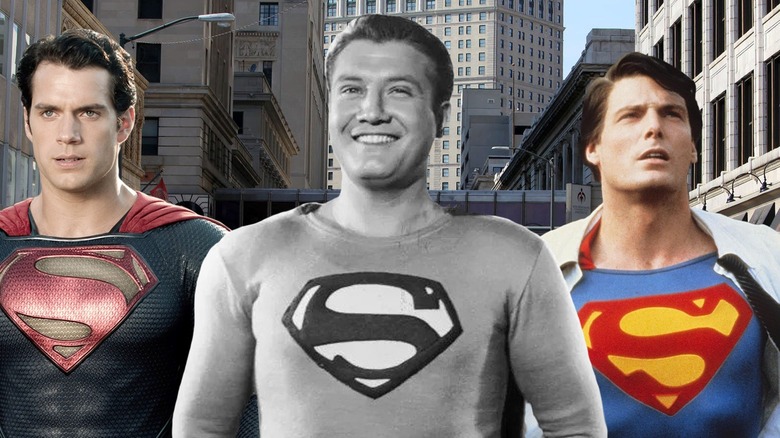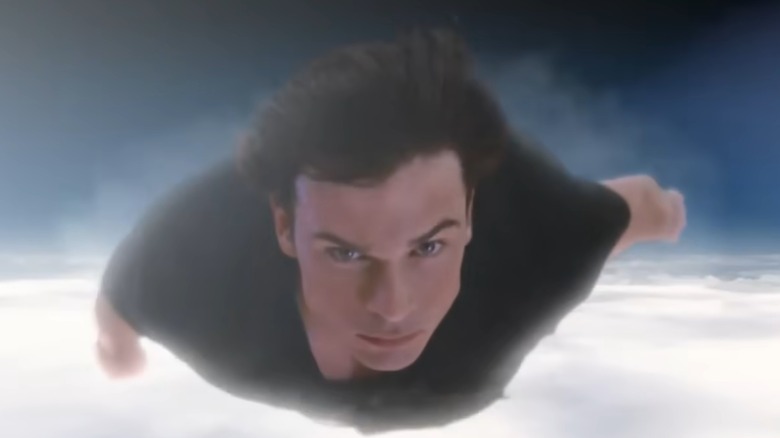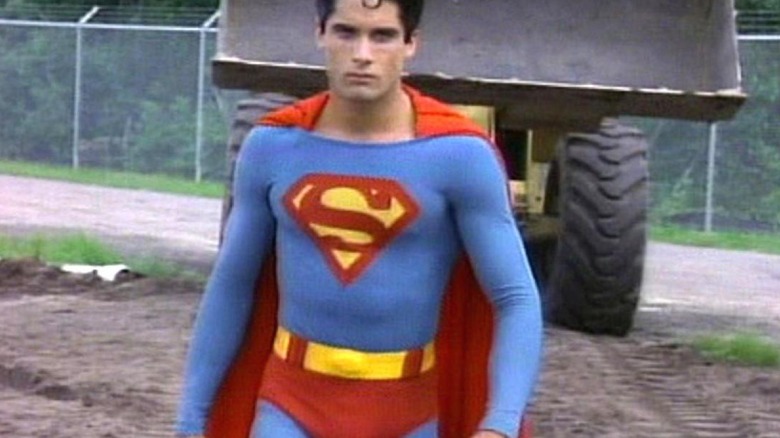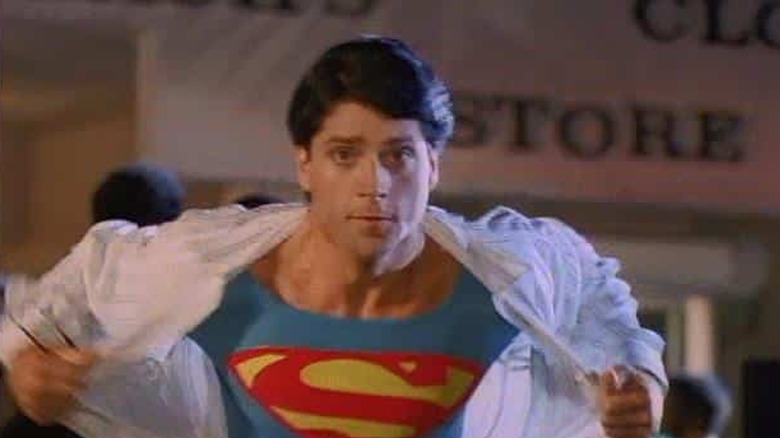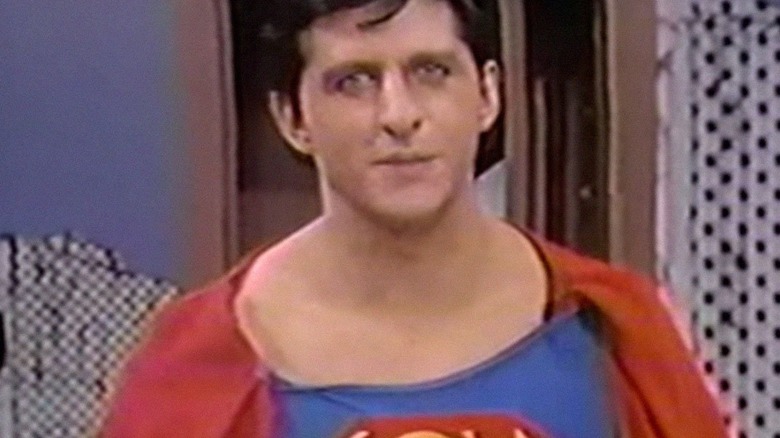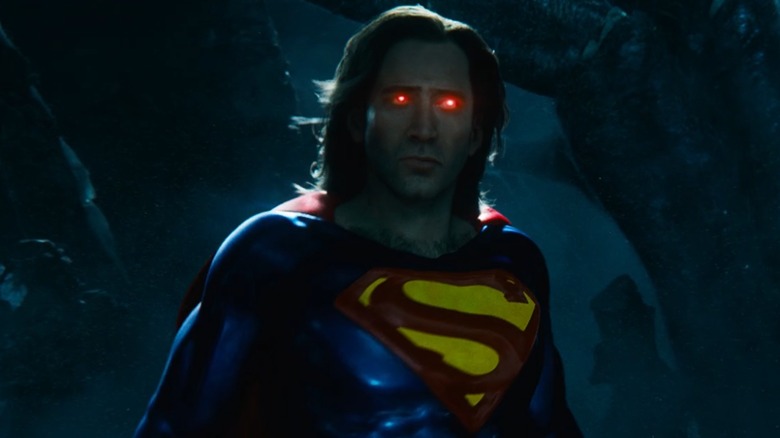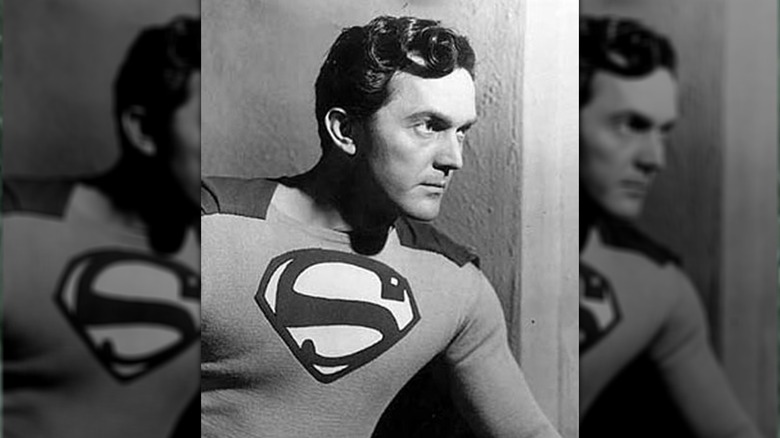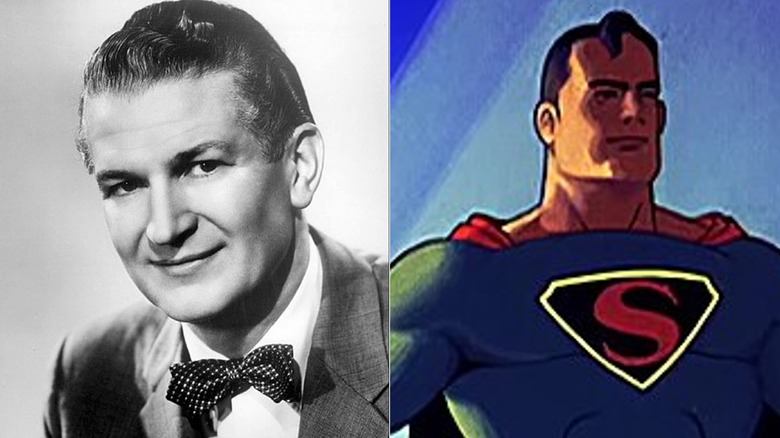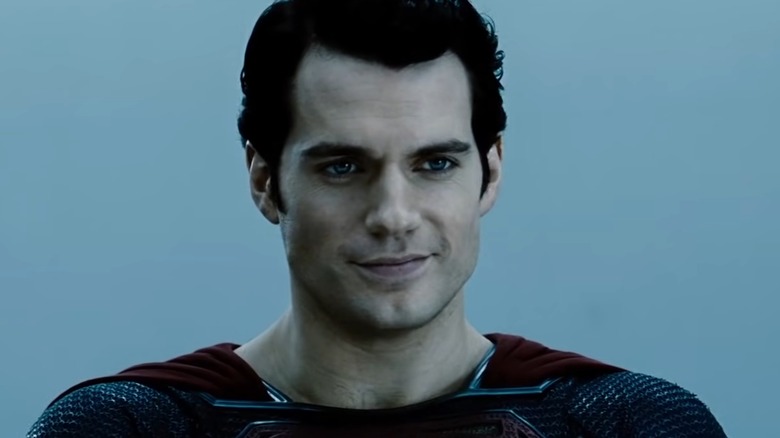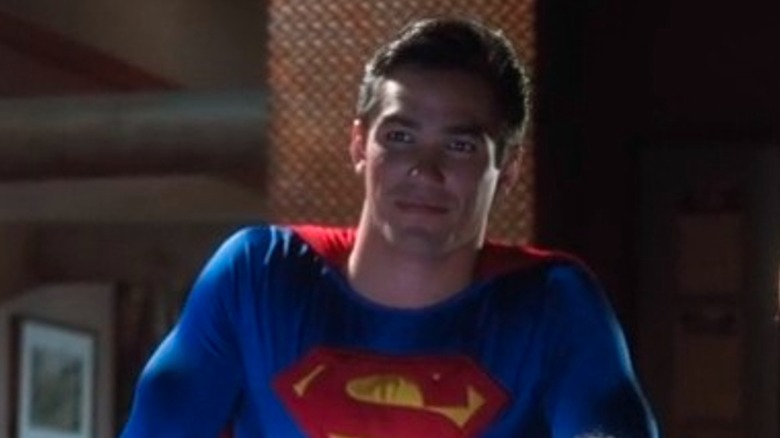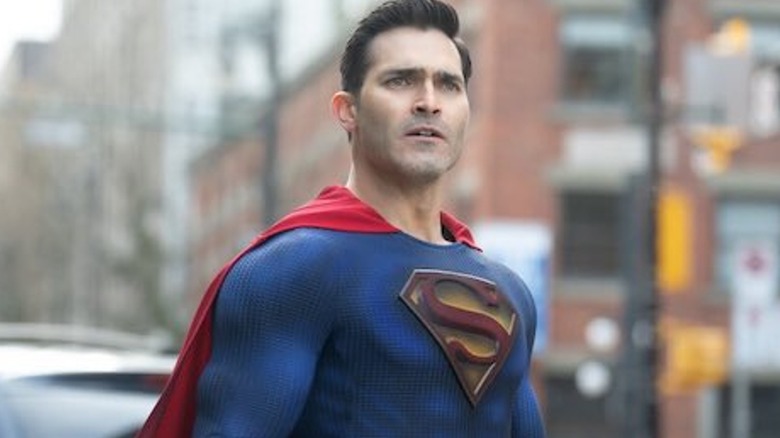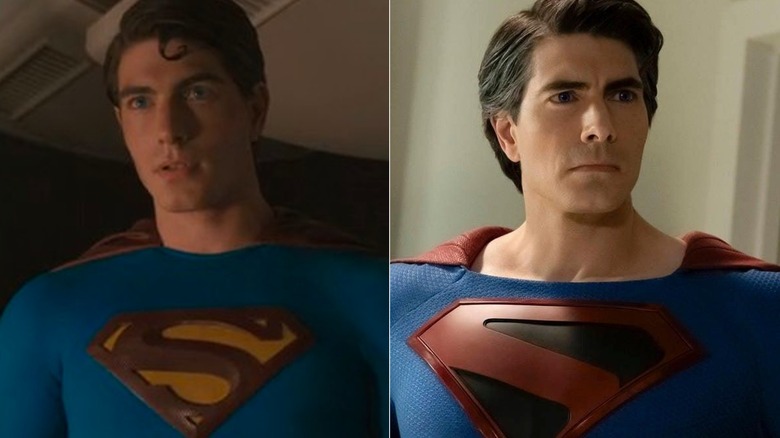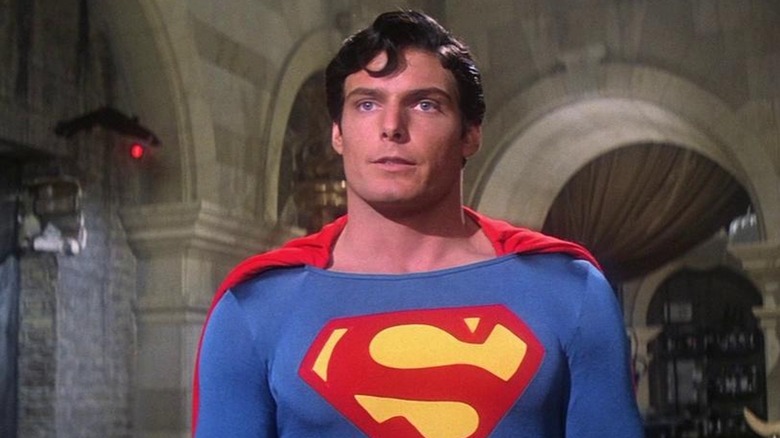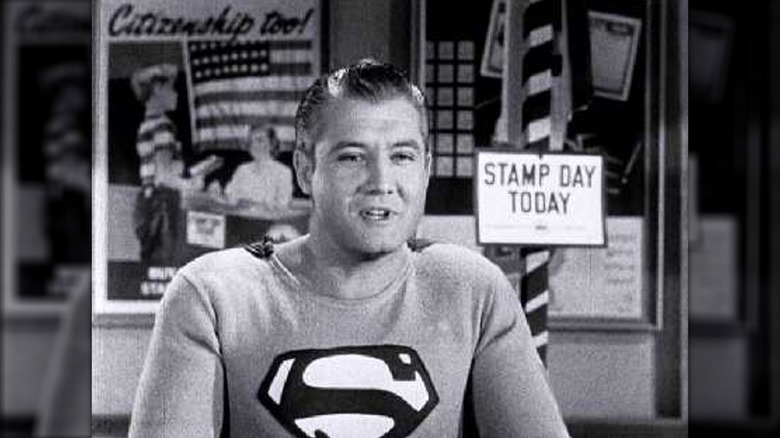Every Superman Actor Ranked By Comic Book Authenticity
Superman has long been an American icon, first appearing in 1938's "Action Comics" #1. As the character gained popularity, he established many of the tropes associated with superheroes, including wearing skin-tight costumes and rocking a cape. As time passed, Superman evolved, transitioning from leaping over tall buildings in a single bound to flying through the sky and, eventually, outer space.
While many of those changes were added gradually, one thing that happened quickly was Superman's representation in other mediums. The first was radio in 1940, which was followed by television and feature films. More than a dozen talented actors have portrayed Superman, and each one put their own unique spin on the Man of Steel.
But comic book accuracy is still important, thanks to the massive fanbase surrounding the character. If an actor alters the character too much, they won't resonate with the fans. The actors here all played Superman in their own way, and their adherence to comic book accuracy depends on what was happening with the character in the comics at the time of their initial performance. These actors are ranked by how closely their version of Superman sticks to the comics.
13. Tom Welling
"Smallville" hit the airwaves in 2001, presenting an entirely new take on the development of Superman. Tom Welling didn't play Superman in the show, and he didn't play Superboy either; he played Clark Kent. That's an important distinction because, unlike the previous "Superboy" series, "Smallville" placed numerous limitations on what could and couldn't appear in the show. Initially, flying was a no-go, and Clark's abilities came staggered over time. This made Welling's character far different from his comic book counterpart.
That's not to say Welling didn't blast it out of the park — he did for 10 seasons. Still, aside from carrying a hit TV series based on Superman's lore, there's very little about his Clark Kent that lines up with the comics. The most notable difference is the lack of costume. Clark was called "The Blur" through much of the series, and while he wore colors similar to his costume in the comics, it wasn't the same.
Welling eventually donned the familiar red and blue, but only at the end of the series. Ultimately, "Smallville" touched on many aspects of Superman's lore, but the representation of Clark as a superhero was unique. Welling reprised his role in "Crisis on Infinite Earths," but had one rule: no costume. Seeing him after eight years was a treat, but comic book accuracy wasn't involved in making it happen.
12. John Haymes Newton
The original "Superboy" television series from 1988 featured characters like Lana Lang, Perry White, Lex Luthor, and the Kents from the comics. The series focused on Superboy during his college years in Florida, which, at the time, was a new concept. Superboy had been absent from live-action until this series, although the character was all over the comics, having debuted in "Superboy" #1 in 1949.
Despite this, the series has entirely new, non-comic-inspired storylines. Additionally, DC Comics erased Superboy from its continuity the year prior via John Byrne's "Man of Steel" reboot, so "Superboy" stood on its own.
Because of this, John Newton's take on the Boy of Steel doesn't mesh well with the comics at the time he donned the cape. "Superboy" would have had to air back in the '50s to come close. Still, even with so much of the character failing to match up with its contemporary comic book counterpart, Newton's Superboy does plenty to ground it in the franchise. His costume is reminiscent of the one worn by the Man of Steel in "Superman: The Movie," and Newton certainly looks the part. Unfortunately, Newton didn't remain on the series for long.
11. Gerard Christopher
John Haymes Newton played Superboy for a single season before he was replaced by Gerard Christopher. "Superboy" continued for three seasons before the show went off the air. When Christopher came on board, he wasn't the only change. The actor playing Lex Luthor was swapped, and T.J. White left to make room for Andy (who only lasted two seasons). The series also took on a darker tone, and in the third season, the title was changed to "The Adventures of Superboy."
While combining Newton and Christopher in a single entry would be feasible, the latter has more in common with the comics than his predecessor. When Season 2 aired, DC Comics launched a companion series called "Superboy: The Comic Book."
"Superboy: The Comic Book" didn't fall within the DC Comics continuity, so it's arguable whether or not Christopher's tie-in comic makes his portrayal more comic book accurate. Regardless, Christopher played the character well, and like his predecessor, he looked the part. A few years later, Christopher nearly landed the lead in "Lois & Clark: The New Adventures of Superman," but was cut for having already played the character.
10. David Wilson
In 1966, the story of Superman was adapted into a musical called "It's a Bird! It's a Plane! It's Superman!" It only ran for less than four months, despite modest critic approval. It was Broadway's biggest flop to date, but CBS adapted it into a TV special in 1975 anyway. If you think adapting a flop into another medium is risky, you're not wrong.
Unfortunately, several of its best songs were cut for TV, and the resulting special is ... well, it's nothing special. David Wilson took on the role of Superman and Clark Kent for the show, and there's not much that works or aligns with the comics. The "Superman" books in 1975 featured a pre-Crisis Man of Steel who was significantly overpowered, serious in tone, and, despite his ability to fly, somewhat grounded in realism.
The TV special is anything but serious and attempts to mimic the campy nature of the "Batman" series from the 1960s. The sets were made to look like comic book panels, which were aesthetically pleasing but too different from the comics to work. That said, Wilson's costume is a good representation, though his lack of muscle definition begs the question, 'Why didn't he wear a muscle suit?'
9. Nicolas Cage
Before "The Flash" hit theaters, few outside the Superman fandom associated Nicolas Cage with the Man of Steel. Cage was initially cast to play Superman in Tim Burton and Kevin Smith's "Superman Lives." Test footage of Cage in costume was leaked, but without further development, Cage's dream of playing Superman remained precisely that ... a dream.
"The Flash" made it a reality, and Cage's Superman looks exactly like he did in the test footage. His fight with a giant spider-like alien is straight out of Smith's script, so Cage's brief cameo is accurate to its source. That said, comic book accuracy is another thing, and Cage's take on the Man of Steel isn't fully aligned with the comics. When Smith wrote the script in 1996, he put various aspects of Superman's lore into a workable story.
Superman died in "The Death of Superman" event in 1993, but it didn't take long for him to return. When he did, he featured some stylistic changes, including a glorious mullet. Cage's hair in "The Flash" is comic book accurate for the time his character was written, and his costume is a good approximation as well, so against all odds, Nicolas Cage's Superman is a decent representation of the late-1990s "Superman" comics.
8. Kirk Alyn
Long before superheroes were represented in massive feature films, many popped up in serials. Kirk Alyn starred as Clark Kent in the very first "Superman" serial, released in 1948 in 15 parts. The serial's length is 244 minutes, so Alyn's "Superman" movie is 40 minutes longer than "Superman: The Movie."
When "Superman" was released, the Man of Steel had been published for a decade, so there was plenty of source material to adapt. Alyn's Superman and Clark Kent aligned fairly well with the comics regarding his costume and backstory. In an odd take on promoting the film, Alyn wasn't credited: He was billed as Superman, making it seem like the Man of Steel himself was taking some time off from punching bad guys to shoot a movie.
Alyn made it work, and the serial offers a great retelling of Superman's origin story, beginning on Krypton, landing in Kansas, and fighting crime in Metropolis. The only problem with the first "Superman" movie was the budget, which was clearly lacking. This is never more apparent than during Superman's flying scenes. Alyn moves to soar into the sky and is immediately replaced with an animated version of the character, who is replaced by Alyn when he lands. It's bizarre, but it works.
[Featured image by Columbia Pictures via Wikimedia Commons | Cropped and scaled | Public Domain]
7. Bud Collyer
Of all the actors who played Superman over the years, Bud Collyer stands as the true original. Collyer played the lead in "The Adventures of Superman" radio series from 1942 until 1951 in over 2,000 episodes on the radio, also voicing the character on the Max Fleischer "Superman" cartoon from 1941 to 1943. His work helped establish the Man of Steel outside of comics, and Collyer played the character far more than anyone else in this article.
While all that's true, Collyer doesn't match up to his peers in one obvious way: he never played the character in live-action. In some ways, Collyer was limited by the medium available in his day, but radio and animation also allowed him to play a character he otherwise wouldn't have.
Collyer's take on Superman helped establish the character, and his work was very representative of the comics. Collyer was the reason Kryptonite exists – it didn't originate in the comics. Collyer reportedly wanted to take a vacation, so Kryptonite was created to give him some time off. While Collyer was out, another actor made groaning sounds in his stead, and Superman's greatest weakness was born!
[Featured image by CBS Television via Wikimedia Commons | Cropped and scaled | Public Domain]
6. Henry Cavill
Henry Cavill brought Superman to life in 2013's "The Man of Steel," launching the DC Extended Universe. Cavill's performance reflected director Zack Snyder's darker tone, taking some cues from Christopher Nolan's "Dark Knight" trilogy. The film retells Superman's origin story but adds details absent from previous adaptations and comic books. It opens with Jor-El taking the genetics codex of Krypton and infusing it with his infant son before sending him to Earth.
This establishes the conflict that unfolds decades later with the arrival of General Zod, but it also upends decades of Superman origin tropes. This leads to incredible fight sequences unlike any that appeared in any of the live-action "Superman" adaptations that came before. It added a lot to the franchise in terms of visual storytelling on the big screen, but several aspects of Cavill's take on Superman don't mesh well with the comics — and it doesn't have to do with the costume, despite lacking the iconic red pants.
Superman is all about inspiring hope — that's who and what the character has been for nearly a century, but that's not Cavill's DCEU Superman. Instead, he's forced to kill Zod, and in doing so, he sacrifices his moral core. It works within the movie's narrative but separates Cavill's Superman from his peers by depicting him in a much darker tone that doesn't exactly fit Superman in the comics in the 2010s.
5. Dean Cain
Dean Cain had the enviable task of bringing Superman to the small screen via "Lois & Clark: The New Adventures of Superman." The series depicts Clark Kent's life as he starts working for the Daily Planet in Metropolis, dons his Superman costume for the first time, and regularly saves the day.
Outside of the romantic elements between Lois and Clark, the series did a decent job approximating the comics. Cain's Superman was based on John Byrne's interpretation of the character in his iconic "Man of Steel" miniseries from 1985. In this regard, Cain's Superman is an accurate portrayal, as he gets the costume and mannerisms down perfectly. "Man of Steel" rebooted Superman's story, updating it for the modern age, and that's essentially what "Lois & Clark" does, only for television.
"Lois & Clark" helped reintroduce Superman while bringing a new generation in simultaneously. The series only ran for four seasons between 1993 and 1997, and after Clark's secret identity was out in the open, it suffered somewhat. Despite this, Cain is remembered for making Superman a more honorable, honest, and compassionate hero, just as he was depicted in the comics a decade earlier.
4. Tyler Hoechlin
Tyler Hoechlin landed the role of Superman in "Supergirl," and he fit the character so well that it wasn't long before he landed his own series, "Superman & Lois." Hoechlin didn't even have to audition for the role — the producer, Greg Berlanti, hand-picked him for the part. He met with the producers on a Monday, and that Friday, he was offered the job. Hoechlin's Superman continues the Cavill-esque choice of ditching the iconic red pants, but in Hoechlin's case, the costume is comic-book accurate.
That's because Hoechlin's Man of Steel is based on Superman as he is depicted in "Superman: Rebirth." The "Rebirth" storyline takes place after "Flashpoint," so it's a reboot of the character. That's not uncommon for DC Comics, which has been rebooting and retooling the continuity of its comics for decades, with Superman often at the center of it all. In "Rebirth," Superman's focus is on raising his son, Jonathan Kent, and "Superman & Lois" covers this storyline well.
If you take a look at the "Rebirth" storyline and the television show, you'll see much of it lines up. DC Comics published a companion tie-in series, "Earth-Prime," to focus on its superhero TV show, with the second issue covering Hoechlin's version of Superman. The story, costume, plot elements, characters, and Superman's interactions with his cousin in "Supergirl" are comparable to the comics in ways Hoechlin's TV predecessors failed to match in a meaningful way.
3. Brandon Routh
Nearly 20 years passed between "Superman" films when "Superman Returns" finally hit the silver screen. The film features the same Superman from "Superman: The Motion Picture" and "Superman II," while completely ignoring the franchise's third and fourth films. This makes it a sequel to a movie released in 1980, and it gave Brandon Routh a difficult task: He had to portray the Man of Steel modeled after Christopher Reeve, which is a pretty high bar for anyone.
Unfortunately, the film failed to meet expectations and has received criticism for various reasons. But it's unfair to blame Routh for these issues, because he nailed his performance. Routh is a convincing Reeve-Superman, and he even managed to mimic Reeve's take on Clark Kent. This stripped away Routh's ability to add his own spin on the character, but given the nature of the film's storyline, it places him high on the comic book accuracy meter.
In 2019, Routh had the opportunity to return to the red and blue via the Arrowverse crossover "Crisis on Infinite Earths." In the crossover, Routh's Superman is based on the "Kingdom Come" Man of Steel. Once again, Routh turns in a great performance, portraying Superman just as he is depicted on the page. Routh's only problem in terms of accuracy is timing, as his "Superman Returns" depiction is over 25 years out of date, while his "Crisis" Superman is 23 years out of date.
2. Christopher Reeve
For many fans, Christopher Reeve is the ultimate incarnation of Superman, despite appearing 40 years after the character's introduction. "Superman: The Movie" introduced a new generation to Clark Kent, with a thoughtful and sensitive portrayal. The film covers the character's origin and rise to prominence as a superhero in Metropolis. The film was released in 1978, and Superman's costume is identical to what was present in the comics at the time.
Additionally, Reeve conveys a sense of hopefulness that is core to the character, and many consider his portrayal of the Man of Steel to be the best of them all. The first film did an excellent job of matching Superman to the comics, but the second strayed a bit. In the final fight between Superman, Zod, and his goons, Superman shows off some incredibly weird powers that weren't part of the comics at all. This separates his performance from the source somewhat.
Of course, Superman develops some strange superpowers over the years, including hypnosis, firing little versions of himself out of his fingers, and more. Still, he never threw his chest emblem at someone and watched it grow in size and envelop them. Regardless, it's a minor deviation for a portrayal that easily reaches the penultimate position as one of the most comic book accurate Supermen in film.
1. George Reeves
George Reeves landed the role of Superman in the 1951 "Adventures of Superman" TV series, though he was initially reluctant to take it. Despite this, he put on the blue tights and red boots and stepped into America's living rooms as the Man of Steel. The show was an incredible success: Before long, Reeves was a superstar. The series closely resembled the comics published throughout the 1950s.
Superman is a strongman capable of performing amazing feats, and that's precisely how Reeves played him. Of course, Reeves also played Clark Kent, and his take on him perfectly reflects the comics as well. Christopher Reeve (no relation, despite the last name) played Kent as a bumbling fool. In contrast, Reeves played him as a competent, confident reporter who would do anything to get his story.
The series added some powers that weren't in the comics. Superman's bulletproof skin nearly got Reeves killed when a boy showed up to a meet-and-greet with a loaded gun. Fortunately, the kid didn't test Reeves' ability to stop bullets with his skin, but the incident certainly shocked the actor. In an odd twist, Ben Affleck played Reeves in 2006's "Hollywoodland," a decade before he took on the role of Batman.
[Featured image by U.S. Treasury Department via Wikimedia Commons | Cropped and scaled | Public Domain]
